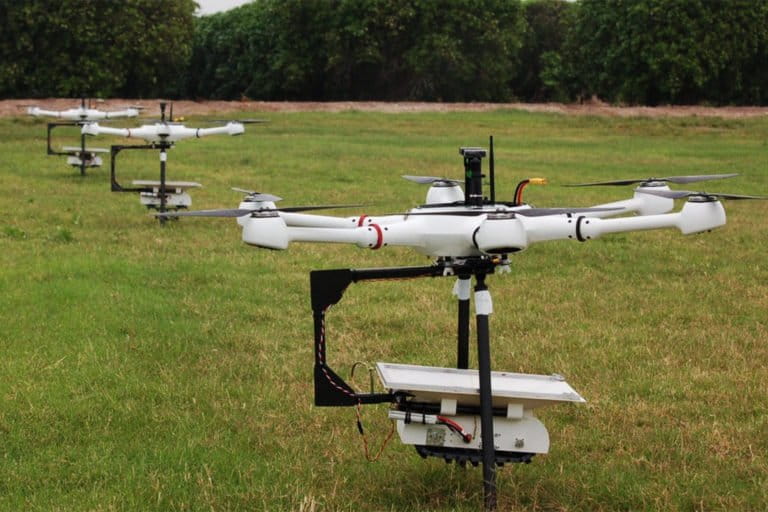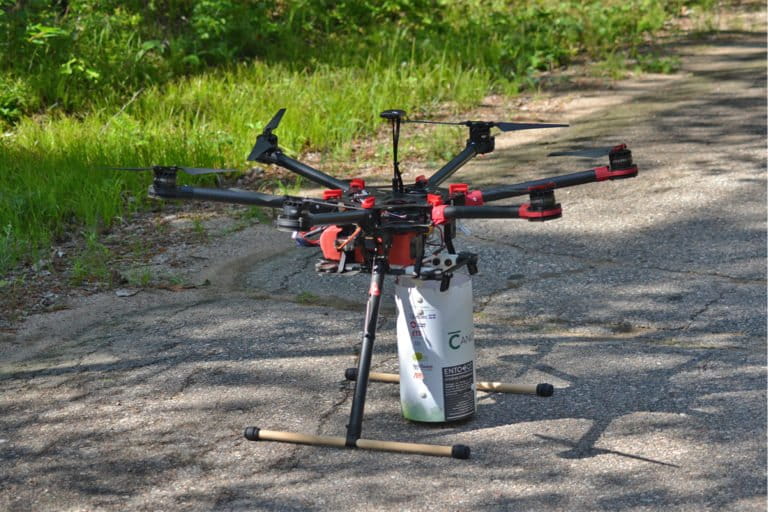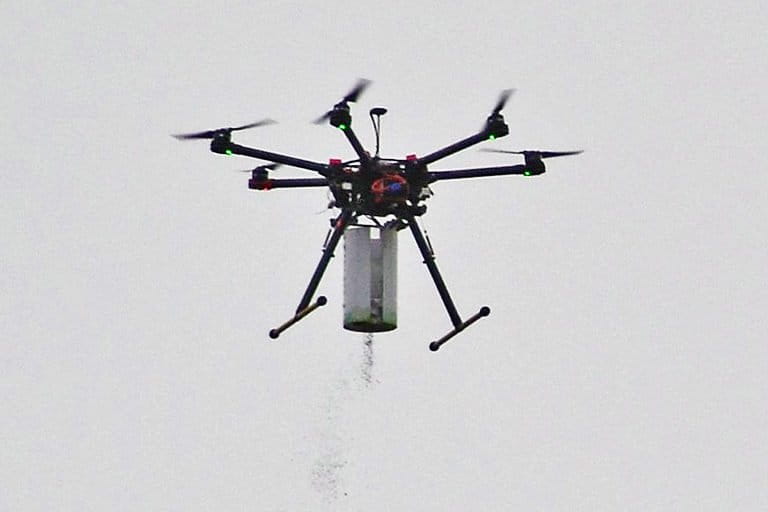- A June special edition of the Journal of Economic Entomology focuses on the potential for using drones in a number of different ways for pest management.
- Proponents of the strategy believe that drone delivery of biocontrols can be used to reduce or, in some cases, replace the use of pesticides, allowing growers to take advantage of the higher prices commanded by organic produce.
- Strict airspace regulations, limited payload capacity and high starting cost are some of the speed bumps to widespread drone usage in agriculture, but experts remain optimistic that drone-based pest management strategies will become more common in coming years.
In some places in North America, the sound of buzzing above fields and forests may no longer foretell trouble, but rather, an innovative solution to a centuries-old problem.
Drones are gaining traction as a method for controlling insect pests in the agricultural sector. Insect damage to crops costs the U.S. alone more than $100 billion per year. Instead of delivering only pesticides, researchers and drone technologists are using the machines to drop something new: more bugs. A special collection published this June in the Entomological Society of America’s Journal of Economic Entomology highlights the potential of drones to assist in pest management strategies that can also reduce the use of agrochemicals.
Researchers are trialing drones to drop natural enemies of pest insects in addition to deploying conventional treatments like mating disrupters or insecticides. The natural enemies, known as biological controls or “biocontrols,” employ natural mechanisms like predation to remove crop pests. For example, one group in Canada tested drones as a means for dropping the eggs of parasitoid wasps (Trichogramma spp.) to combat pests affecting cornfields and mixed spruce forests in Quebec. The wasps hatch, mature, and lay their own eggs in those of the pests.

Much of researcher Véronique Martel’s career has been spent studying wasp biocontrols in agricultural settings. Growers typically distribute wasp eggs via costly manned aircraft flights or through manual placement on the ground. Martel, with the Department of Natural Resources Canada, wanted to see how wasp biocontrols would work in a forest setting, the logistics of forests are very different from those of controlled crop fields.
She initially experienced pushback from colleagues, who felt the strategy was unrealistic. However, the arrival of new technology changed the calculus.
“When I heard they tested [drone delivery] in agriculture, I wanted to do it [in forests],” Martel told Mongabay. “I was jealous.”
Martel and her group partnered with the Canadian company Canopée to deploy paratrooping parasitoids from specially equipped drones. Their study showed that the drones were as effective as the manual method in forest settings, meaning that the technology could be used to treat wider areas than might be reachable on foot.

Drones could replace some pesticide use
Biocontrols are neither new nor uncommon in the world of agriculture. According to Michael Brewer, co-editor-in-chief of the Journal of Economic Entomology, the shift away from biocontrols began as DDT and other pesticides became more common after World War II.
“The nice thing about insecticides is that you can put them in a bottle, right?” said Brewer. He said that while they have the advantage of being easy to apply, insecticides can harm the environment.
However, he noted that biocontrol methods might not work in every case, such as against insects with large, established populations. In those cases, targeted application of insecticides might be a grower’s best option.
“To avoid spraying everything all the time, the few people out there doing pest services need more eyes. That’s where imaging drones come in,” Brewer said.
Depending on the camera on board, a drone can capture color, thermal, or even hyperspectral images. Imaging drones are now widely used in conservation to monitor wildlife and locate rare plants, but they haven’t yet gained a firm foothold in agricultural pest management.


Employing imaging drones allows growers to detect pest infestations early and to apply insecticides only to affected areas. For example, one of the studies published in the Journal of Economic Entomology used drone imagery to find the nests of the oriental moth (Monema flavescens), an invasive species that affects urban landscaping trees and fruit trees.
The company Canopée started out providing drone imagery for landowners, but quickly shifted its focus to interventions. According Canopée vice president Frédéric Jean, the technology behind using drones to deliver biocontrols is not yet ready to be used commercially — but it won’t be a long wait.
“We’re at the cusp,” he said. “Nobody on their feet could come close to being as efficient [as drones].”
Nathan Moses-Gonzales, CEO of the company M3 Agriculture Technologies, expressed a similar view. He says growers are eager to apply the new technology.
“I think that there’s a sort of perspective that farmers aren’t really looking at data. They’re not really thinking about machinery,” Moses-Gonzales told Mongabay. “But it’s actually quite the opposite.”
Moses-Gonzales, a technologist by training, worked alongside the United States Department of Agriculture (USDA) to help combat the Mexican fruit fly (Anastrepha ludens), an invasive and economically damaging agricultural pest that has been documented in Arizona, California and Texas.

The group tested the use of automation to create drone swarms, where multiple rotary-wing drones are flown at the same time. Moses-Gonzales and his team tested their strategy with groups of three or four coffee-table-sized drones, but they have flown as many as 12 drones at a time. The machines are activated from a controller and sent on predetermined routes, either simultaneously or in waves.
“The whole thing, in my mind, just looks insane,” he said. “They sound a little bit like a swarm of bees.”
The drones delivered sterile fruit flies to citrus groves along the Rio Grande, where they bred with wild individuals but produced no offspring, resulting in significant population decreases. Typically, similar strategies would be carried out using ATVs or human-piloted aircrafts.
According to Moses-Gonzales, techniques like these can help growers as public interest in organic produce grows.
“Folks are really starting to think more about what they’re putting into their bodies,” he told Mongabay.

On the cusp — but limitations remain
While growers may see increased profits from lower pest damage and higher prices for organic produce protected by drone-based biocontrol techniques, cost can still be a limiting factor. The upfront investment associated with purchasing or hiring drones may still be prohibitively expensive for some. Even so, it’s already less expensive than using manned aircraft and less labor-intensive than ground-based strategies.
Additionally, there are some key limitations that could slow the rise of what is still a relatively niche area of the agricultural technology industry. Studies are still needed to assess how to most effectively use drones: methods that have been proven effective from the ground may need adjustments when deployed from the air.
The drones themselves also have room for improvement. Commonly cited issues are limited weight capacity and battery life. While today’s drones are efficient in the air, they can only carry so much weight and travel so far before having to return to the launch site.
“We need to invest the money in a drone that’s large enough for you to cover a large enough field … but you need to have permission to operate in those circumstances,” said Canopée’s Jean.

Strict regulations in the U.S. and Canada pose an ongoing challenge to the application of commercial drone technologies. Especially limiting, according to the interviewed experts, is the difficulty of obtaining permission to fly drones beyond the line of sight, which discourages development of larger drones that would be able to fly further and carry heavier payloads.
Still, M3 Agriculture Technologies and Canopée both say they anticipate growth in agricultural applications of drones as the technology progresses and regulatory red tape dissipates.
“The sky’s the limit,” Moses-Gonzales said.
Citations:
Moses-Gonzales, N., Conway, H., Krompetz, D., Rodriguez, R., Adams, C. G., Baez, I., & Milam, M. (2021). The use of multiple unmanned aircraft systems as a swarm to release sterile Mexican fruit fly (Diptera: Tephritidae) into South Texas citrus groves. Journal of Economic Entomology. doi:10.1093/jee/toab024
Moses-Gonzales, N., & Brewer, M. J. (2021). A special collection: Drones to improve insect pest management. Journal of Economic Entomology. doi:10.1093/jee/toab081
Martel, V., Johns, R. C., Jochems-Tanguay, L., Jean, F., Maltais, A., Trudeau, S., … Boisclair, J. (2021). The use of UAS to release the egg parasitoid Trichogramma spp. (Hymenoptera: Trichogrammatidae) against an agricultural and a forest pest in Canada. Journal of Economic Entomology. doi:10.1093/jee/toaa325
Park, Y., Cho, J. R., Lee, G., & Seo, B. Y. (2021). Detection of Monema flavescens (Lepidoptera: Limacodidae) cocoons using small unmanned aircraft system. Journal of Economic Entomology. doi:10.1093/jee/toab060
Banner image of researchers with a drone by Véronique Martel.
